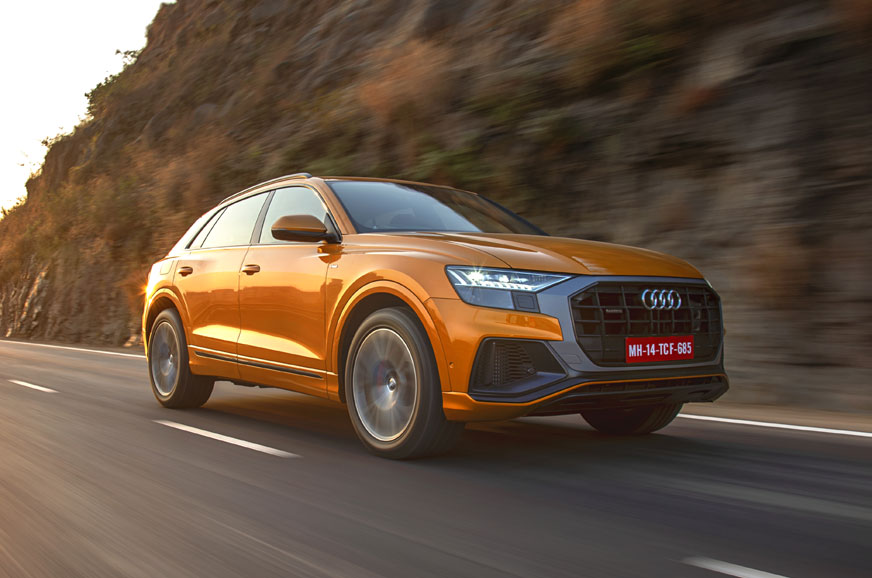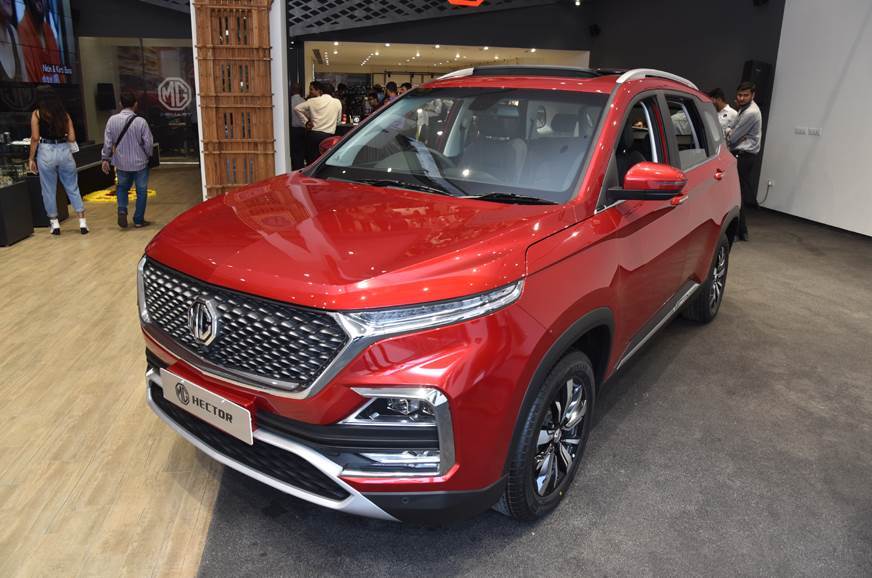
What is it?
It’s Audi’s new flagship SUV, the Q8. It sits, as the number dictates, above the Q7 and alongside the brand’s other two flagships – the A8 and the R8. It’s not quite as long as a Q7 and is only a five-seater, but it’s lower and wider and built on the same wheelbase, sporting a ‘slammed’ roof that puts it in a very special niche of vehicles. It promises to set itself apart within this niche of SUV-coupés like the BMW X6, Mercedes-Benz GLE Coupe – and more recently, the Porsche Cayenne Coupe – by offering a massive array of customisation options. This is possible because the Q8 is a CBU import and Audi says no two customers will have identical-looking cars. The other side of this customisation coin, though, is a four-month waiting period, but if you’re impatient, Audi India will have a selection of pre-customised Q8s for you to choose from.
What’s it like on the outside?
The other thing that sets it apart is that it heralds a new wave of Audi SUV design that will soon make its way to India with the likes of the next-generation Q3 and the facelifted Q7. The pictures do not do the Q8 justice. For one, it’s larger than you think, and though it might seem like just another Audi SUV at first glance, there are so many small details that make it really special. The grille, for instance – it is the typical, massive, octagonal ‘single-frame’ Audi grille, but its pronounced frame gives it the menace of Hannibal Lecter’s muzzle. You can customize the frame, the slats and even the surrounds for the lower air intakes.
The headlamps are the usual angular, Matrix LED units but their DRL design is special and, along with the tail-lamps, they do a little light dance when you unlock your Q8. The bulging rear haunches are a nod to the Ur Quattro rally car, and Audi’s take on the coupé roofline is special, because it doesn’t succumb to that curved, hunchbacked shape. Instead, it tapers gently and then slams down sharply at the C-pillar. And finally, the huge wheels and tyres (20s are standard, while the 21s seen here and 22s are optional) add to its wide, squat stance. It’s not a design I loved when I first saw it but, over the course of the day, it has yanked at my heartstrings. If you want to make a statement, this is a great way to do it.
What’s it like inside?
After 2019’s new A6, the interior is perhaps not as novel; but it’s no less impressive. Here too, you have a great degree of customisation at your fingertips, with a choice of 11 upholstery colours and 9 inlay trims to mix and match. Audi’s new dashboard design simply screams ‘tech’, with its winged trim finished in gloss black, seamlessly housing the dual MMI touchscreens (we’ll get back to these in a moment). The only trouble is it’s angled such that, in peak afternoon light, the reflections off it can be blinding. Fit and finish are, as ever, an Audi hallmark, and though the others have caught up, the richness of materials and the way they’re brought together in here are just about flawless.
There are three screens, the first being the latest generation of Audi’s path-breaking Virtual Cockpit digital dials. You can’t customise this like you can with some rival cars, but they’re so well designed and executed, we have doubt you’d want to. The other two screens are a bit more controversial – the dual MMI infotainment unit relegates almost all functions from the centre console into two touchscreens. The one on top is pretty standard – navigation, media, phone, car settings and the like, while the lower one handles climate control, seat functions and a few other driver features. With just about every function moved to the screen, you’ll find yourself peering down and away from the road quite often – the biggest victims being climate control and driving modes. Audi has built in a haptic feedback system that rewards your inputs with a tactile and audible ‘click’, but this also means you have to jab the screen quite firmly, which is not what you’re used to from a touchscreen. Still, there’s no arguing how good looking and loaded with features it is.
Speaking of features, the Q8 has a pretty generous standard features loadout, with standouts like HD Matrix adaptive LED headlamps, adaptive air suspension, a panoramic sunroof, parking assistant and an incredible-sounding 1,920W Bang & Olufsen hi-fi system. And generous it should be at the Audi Q8’s price, but there are still a few options over and above this – four-zone (rather than dual-zone) climate control, a head-up display, seat heating, ventilation and massage, and rear-wheel steering, to name some.
The front seats on this particular car are superb, with a huge variety of adjustments, including side bolstering and squab extensions. However, the switches on the side of the seat only handle basic movements; for further adjustment, heating, cooling and massage functions you have to go – you guessed it – to the touchscreen.
The backseat is a surprise, offering far more space than you’d expect. With no third row to fit in, legroom is rather vast, and headroom (though not as much as a conventional SUV) is more than in most other SUV-coupés; thanks to that differently executed tapered roof. You’re pampered with the likes of a panoramic sunroof and powered sunshades, but the seat itself could have been cushioned a bit better. At over 600 litres, the boot is big too, but the loading lip is quite tall and big suitcases stacked upright could foul with the sloping tailgate.
What’s it like to drive?
So it’s got almost enough luxury to match up to the A8, its limousine sibling, but could it really have enough performance to match an R8? Of course not; although the 600hp V8-powered RSQ8 that’s likely to be launched later, comes a lot closer. Still, with looks like these, you expect some amount of sportiness – 340hp and 500Nm of torque from a 3.0-litre turbo-petrol V6 does sound pretty decent. 0-100kph in a claimed 5.9sec sounds even better for this 2.1-tonne SUV; but can it deliver?
Against our testing gear it managed a strong 6.07sec in the 0-100 sprint, which is not far from the claim. In practice, though, it doesn’t feel particularly sporty, with power swelling in briskly but calmly. As the numbers attest, it’s not slow; but then it doesn’t feel urgent either, lacking that mid-range thwack you’d have gotten from Audi’s 3.0-litre, V6 diesel – an engine we’re really going to miss. Rev it out and it doesn’t sound particularly sporty either; all you hear is a distant mechanical churn.
This powertrain is at its best, however, when you’re not on the limit. Reach over and fumble around for the Drive Select icon on the far end of the lower touchscreen, switch from Dynamic to Comfort and drive the Q8 55 TFSI at eight-tenths, then it feels far more in its element. Doing this makes you realise just how good ZF’s 8-speed automatic has become in 2020; it’s just as happy slamming-in the ratios at a breakneck pace, as it is sliding silently through them in traffic. It’s then you’ll find that this is an incredibly refined engine that’s very smooth in its power delivery at all revs.
What truly comes as a surprise is the ride quality. Oftentimes, large SUVs like this, riding on air suspension with massive wheels and tyres, tend to feel a bit lumpen and fidgety, but Audi has managed to get it spot on with the Q8. The air suspension isn’t overly soft or floaty, but it also doesn’t get too uncomfortable in Dynamic mode. Our test car is running 21-inch wheels on 285/45 R21 tyres, and they still have a pretty generous amount of rubber sidewall around the rim (an indication of just how massive this car really is). This means that they’re surprisingly good at absorbing the sharp hit off the edge of a pothole, for instance.
Great ride quality usually comes with a trade-off to handling; but again, Audi has done a commendable job of balancing things out. You need to have the suspension in Dynamic mode of course, but body control is impressively contained; only something like a Porsche Cayenne does a better job of it. What is still not up to the mark, and is starting to sound like a bit of a cliché now, is the steering, which just isn’t as sharp or communicative as you’d like in a car of this type and price. That said, it makes up for it, in part, with an incredible agility afforded by the optional rear-wheel steering. It takes away a lot of this car’s bulk from behind the wheel and gives you a lot more confidence to tuck it into corners.
Should I buy one?
There have been a few mentions of price over the course of this review, so to end the suspense, here it is – Rs 1.33 crore (ex-showroom), before options and customisation. That’s around Rs 50 lakh more than a Q7 and bang alongside the Q8’s more posh cousin, the Porsche Cayenne Coupe. Now while this might drive away some of the brand snobs, stick around, because there’s a lot to like here.
The Q8 is the quintessential flagship, packing in everything we love about Audi; and as such, it carries a flagship price. It’s got an incredibly well-executed interior with a surprising amount of space, it is well-kitted-out before the options start, and it rides really well. The performance and handling may not match up to its price or the way it looks, but those looks alone might be enough – it is truly a stunner. Audi, however, is counting on the customisation to really drive the Q8 to its intended customers, and that might just be the right approach. The original Q7 was a hit amongst the jet set in India – mainly Bollywood stars and big industrialists; and what do they like most? Standing out from the crowd. So while the Audi Q8 might not sell in large numbers, it’s the exclusivity and personalisation that will, rather literally, set it apart.
from Autocar India https://ift.tt/376hpOV
via IFTTT

No comments:
Post a Comment